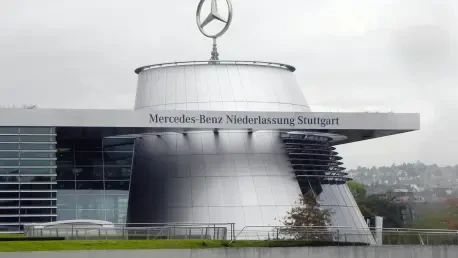In a transformative move that could redefine the trajectory of one of the world’s most iconic automotive brands, Mercedes-Benz has unveiled a bold restructuring plan to merge its vehicle sales and financial services divisions into a single, cohesive entity. This strategic decision, aimed at streamlining operations and boosting efficiency, involves integrating Mercedes-Benz Mobility AG into Mercedes-Benz AG. Scheduled for completion by the end of this year, pending regulatory approvals, the merger signals a significant shift in the company’s organizational framework. As the automotive industry faces mounting pressures from market fluctuations and evolving consumer demands, this initiative raises compelling questions about how such a consolidation might strengthen the company’s position. With a focus on operational unity and financial resilience, this restructuring could pave the way for innovative customer solutions and a more agile business model, setting a precedent for others in the sector.
Strategic Consolidation for Operational Efficiency
The essence of this restructuring lies in creating a unified operational structure that blends the vehicle sales division with financial services, a move designed to eliminate redundancies and enhance overall efficiency. By merging Mercedes-Benz Mobility AG into the broader framework of Mercedes-Benz AG, the company aims to simplify internal processes while maintaining a sharp focus on delivering value to customers. Financial services, such as leasing and financing, are integral to the automotive sales ecosystem, often influencing purchasing decisions. Integrating these functions under one roof could enable more seamless offerings, potentially improving customer satisfaction and driving revenue growth. Importantly, despite this consolidation, certain critical aspects of financial services will remain under a dedicated unit, Mercedes-Benz Financial Services, to ensure compliance with regulatory standards. This careful balance between integration and adherence to legal requirements demonstrates a thoughtful approach to restructuring, prioritizing both innovation and responsibility in equal measure.
Beyond the operational benefits, this merger reflects a broader vision of adaptability in a rapidly changing industry landscape. The automotive sector is increasingly driven by digital transformation and customer-centric models, where the ability to offer tailored financial solutions alongside vehicle sales can create a competitive edge. For Mercedes-Benz, combining these divisions may facilitate quicker decision-making and resource allocation, allowing the company to respond more effectively to market trends. Additionally, this move could reduce overhead costs associated with managing separate entities, freeing up capital for investment in emerging technologies like electric vehicles and autonomous driving systems. While the full impact of this integration remains to be seen, it positions the company to navigate future challenges with a more streamlined and cohesive operational base, potentially setting a benchmark for how traditional automakers can evolve in a modern, tech-driven era.
Leadership Transitions and Continuity Planning
As part of this transformative merger, significant leadership changes are on the horizon, starting with the departure of Franz Reiner, the Chairman of the Board of Management at Mercedes-Benz Mobility, at the end of this year. Reiner, who began his journey with the company in 1992, has been instrumental in shaping the financial services division over three decades, earning recognition for his visionary approach and dedication. His contributions have been pivotal in fostering sustainable growth, as noted by Harald Wilhelm, a key figure on the Mercedes-Benz Group Board of Management. Wilhelm commended Reiner’s international expertise and pioneering spirit, emphasizing his role in preparing the division for future success. This exit, though a loss of seasoned leadership, has been planned with mutual agreement, reflecting a strategic approach to transition that prioritizes the company’s long-term stability over individual tenures.
To ensure continuity during this critical period, a structured succession plan has been put in place, with Peter Henn, currently the President and CEO of Mercedes-Benz Financial Services USA, set to take over global leadership of the financial services division starting next year. Until then, Tolga Oktay, a current board member responsible for finance and controlling at Mercedes-Benz Mobility, will oversee operations, reporting directly to Harald Wilhelm. This interim arrangement underscores the company’s commitment to maintaining operational steadiness amidst change. Henn’s appointment brings a fresh perspective backed by extensive experience in the American market, which could prove valuable as the company seeks to expand its global footprint. These carefully orchestrated transitions highlight a deliberate effort to preserve expertise and institutional knowledge, ensuring that the merger’s benefits are not undermined by leadership gaps or disruptions in strategic direction.
Market Context and Industry Implications
Recent performance metrics for Mercedes-Benz Cars reveal a challenging backdrop to this merger, with a reported 3% decline in sales compared to the previous quarter and a steeper 12% drop from the same period last year. Although no direct link between these figures and the restructuring decision has been confirmed, the timing suggests that the company might be seeking ways to bolster its resilience against market headwinds. The integration of financial services with vehicle sales could be a strategic response to optimize resources and improve profitability during a period of softening demand. By aligning operations more closely, Mercedes-Benz may be better equipped to weather economic fluctuations and competitive pressures, potentially using the merger as a catalyst for reevaluating cost structures and investment priorities in a crowded automotive landscape.
Looking at the broader industry, this restructuring aligns with a growing trend among automakers to integrate financial services with core operations, aiming for a more holistic customer experience. Financing and leasing options are often critical touchpoints for buyers, and merging these functions can enable companies to craft more personalized and accessible solutions. For Mercedes-Benz, this could mean enhanced digital tools for financing or bundled offerings that simplify the purchasing process. Such strategies resonate with the industry’s shift toward digitalization and customer focus, where seamless integration across sales and services is increasingly seen as a differentiator. If successful, this merger could inspire similar consolidations among peers, reinforcing the notion that operational synergy is key to thriving in an era defined by rapid technological advancements and shifting consumer expectations.
Reflecting on a Pivotal Shift
Looking back, the decision by Mercedes-Benz to merge its financial services and vehicle sales divisions marked a calculated step toward greater efficiency and adaptability in a competitive market. The integration of Mercedes-Benz Mobility AG into Mercedes-Benz AG, completed with regulatory oversight, stood as a testament to the company’s foresight in addressing operational challenges. Leadership transitions, including the departure of Franz Reiner and the subsequent appointments of Peter Henn and interim overseer Tolga Oktay, were handled with precision to ensure stability. Amidst a backdrop of declining sales figures, this restructuring emerged as a potential turning point, offering a framework for resource optimization. Moving forward, stakeholders can anticipate how this unified structure might drive innovation in customer offerings and operational agility, while industry observers might consider this a model for balancing consolidation with compliance. This strategic pivot laid a foundation for navigating future uncertainties with renewed strength.









